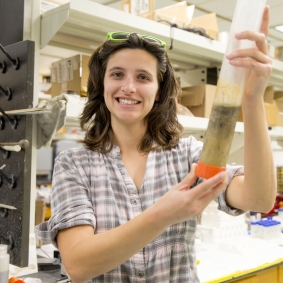Knauss legislative fellowships in Congress help build careers — and they're fun and educational. See our video and fact sheet for details.
Emily Russ

Fellowship Institution:
U.S. Army Corps of EngineersStart Year:
2019Emily Russ will be working with the U.S. Army Corps of Engineers in the Engineer Research and Development Center as an Advisor to the Technical Director. She will be working on topics ranging from marine transportation to hurricane resilience.
Russ obtained her bachelor’s degree in marine and coastal resources from North Carolina State University. She then continued into a master’s program where she received a degree in earth science, with a focus in coastal geomorphology, and a certificate in GIS. She is recently defended her Ph.D. at the University of Maryland Center for Environmental Science, Horn Point Laboratory (HPL), where her research examined sediment transport connectivity between the lower Susquehanna River and upper Chesapeake Bay. While at HPL, she discovered a passion for promoting coastal resilience through outreach education. During her free time, Russ enjoys baking, hiking, and playing ultimate Frisbee.
Call for Symposium Presenters and Authors
The Chesapeake Rising: Innovative Law and Policy Solutions for Climate Adaptation in Coastal Communities symposium will explore key legal and policy considerations that affect climate adaptation strategies. It provides a unique opportunity for upper-level law students and early-career lawyers to present and publish their legal scholarship.
Program Announcements
-
-
Maryland Sea Grant has program development funds for start-up efforts, graduate student research, or strategic support for emerging areas of research. Apply here.
News and Blogs
Video Gallery
Sea Grant Film Explores a Diminishing Smithville
Smithville is a community on Maryland’s Eastern Shore, on the edge of the Blackwater National Wildlife Refuge. A century ago, Smithville had more than 100 residents. Today, it has four, in two homes: an elderly couple, and one elderly woman and her son, who cares for her.
Featured Fellow
Featured Research Project
Developing a habitat model for mysids, an important link in Chesapeake Bay food webs
Mysids are important mesozooplankton prey for many species of fish in Chesapeake Bay and are an important link in transferring energy from lower to upper trophic levels. Mysids also serve as biological vectors for benthic-pelagic coupling due to their diel vertical migration and omnivorous prey-switching behavior, which makes mysids important regulators of food web architecture. Despite their central role in coastal food webs, surprisingly little is known about mysid ecology and dynamics in Chesapeake Bay.
The Blue Crab: Callinectes Sapidus
An essential resource for researchers, students, and managers. Get your copy today!


©2025 Maryland Sea Grant. All rights reserved.
5825 University Research Court, Suite 1350 | College Park, MD 20740
Phone: (301) 405-7500 | Fax: (301) 314-5780 | Contact Us



